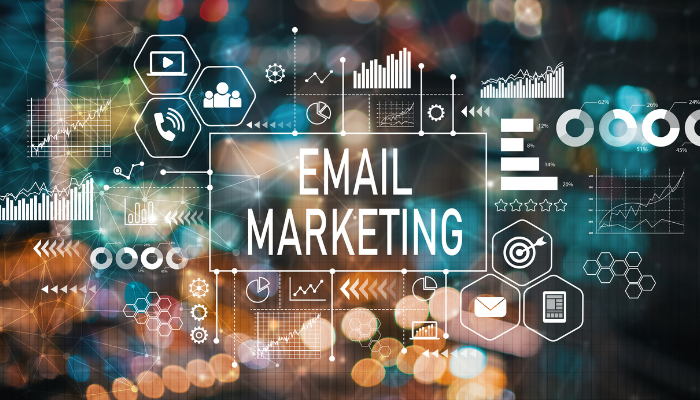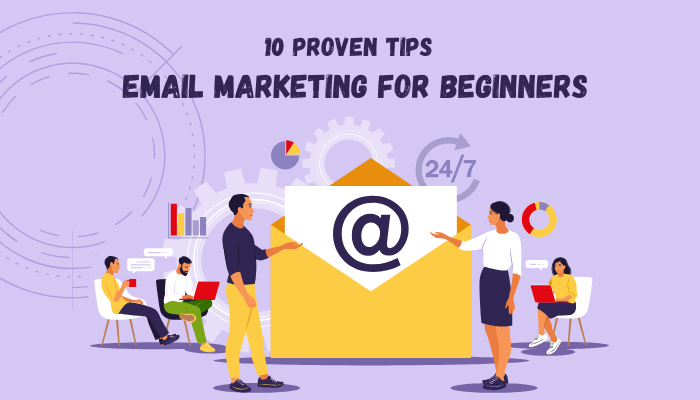Table of Contents
1. Introduction
Email Marketing for Beginners: So, you’re thinking about diving into email marketing? Nice! Honestly, it’s one of those things that might feel a bit intimidating at first—like, “Where do I even start?” But once you get the hang of it, it’s kind of magical. You get to talk directly to your audience, show them what you’re all about, and even make some sales while sipping coffee in your pajamas.
In 2025, even with flashy social media platforms and AI everything, email marketing is still crushing it. Why? Because it’s personal. It’s yours. No algorithm changes or viral trends to chase. That’s why so many small businesses and solo creators are diving into email marketing for beginners.
In this guide, I’ll walk you through everything you need to know about email marketing for beginners. We’ll keep it real, casual, and packed with helpful stuff. From building your list to writing that first email—it’s all here.
2. What Is Email Marketing?
Let’s break it down without the jargon. Email marketing is just using email to connect with people—whether you’re selling something, sharing tips, or just saying “Hey, I exist.”
Why It’s Worth Your Time:
- It’s cheap (or even free to start).
- It gets results—like real ones.
- You don’t have to shout over a million posts to be heard.
Different Types of Emails You’ll Probably Use:
- Promotional – Flash sales, launches, announcements.
- Transactional – Receipts, order confirmations.
- Automated – Set-it-and-forget-it sequences like welcomes or follow-ups.
It’s not about being pushy—it’s about being helpful, relevant, and human. Especially if you’re following an email marketing beginners guide like this one.

3. Why Email Marketing Still Works in 2025
Here’s the deal: email isn’t dead. In fact, it’s aging like fine wine. That’s one of the big reasons people are still turning to email marketing for beginners.
People still check their inboxes. Multiple times a day, actually. And unlike social media, you’re not fighting for attention in a feed full of memes and cat videos.
Some eye-popping stats:
- Email marketing brings in about $42 for every $1 spent. That’s wild.
- You actually own your list. Facebook or Instagram can shut down your page tomorrow. Your email list? Still yours.
- Email has higher engagement rates compared to most social channels.
Honestly, if you’re still asking whether email marketing is worth it, the data kind of shouts “YES!”
4. Choosing the Right Email Marketing Platform
Picking a platform is like picking shoes. It has to fit you. And when you’re just starting out with email marketing for beginners, that choice really matters.
A Few Beginner-Friendly Options:
- Mailchimp – Super popular, easy drag-and-drop builder.
- MailerLite – Clean interface, great for automation.
- ConvertKit – Loved by bloggers and creators.
- Brevo – (formerly Sendinblue) – Strong on automation + SMS.
What To Look For:
- Easy to use (no need to code anything)
- Automation features (because time = money)
- Solid templates (you don’t wanna design from scratch every time)
- Analytics (because how else do you know what’s working?)
Start with the free version. Seriously. Play around. You’ll figure out what you actually need as you go.
5. Building Your Email List from Scratch
This part freaks people out a bit. Like, “But I don’t have anyone to email!”
It’s okay. Everyone starts from zero. That’s part of the journey with email marketing for beginners.
Here’s how to do it right:
- Don’t buy email lists. Just… don’t. It’s sketchy and won’t work.
- Create a lead magnet – Something free and useful: a checklist, a quick guide, a discount code.
- Use opt-in forms – Put them on your homepage, blog posts, even at checkout.
- Try pop-ups – Done tastefully, they actually convert well.
Oh, and legal stuff? Yeah, that matters. Make sure you follow GDPR, CAN-SPAM, and all that good stuff. Basically, ask permission, and don’t spam people. Simple.
6. Writing Your First Email
This is where it gets real. Your first email. It doesn’t need to be perfect—just honest and helpful. If you’re new to this, don’t worry—email marketing for beginners isn’t about perfection.
Nail the Subject Line:
- Keep it short (under 50 characters is good)
- Make it interesting—spark curiosity
- Avoid sounding spammy (no “Buy NOW!!!”)
Email Copywriting for Beginners:
- Talk like a human. Not like a robot. Not like a professor.
- Tell a quick story. Make a point. Add value.
- Be real. If you’re nervous, say it. People appreciate honesty.
And don’t forget the CTA:
- Ask them to check out something cool
- Invite replies (those are gold!)
- Link to your latest blog or offer
“Hey, just hit reply and tell me what you think.” works surprisingly well.
7. Creating a Welcome Email Series
Ever walk into a party and no one says hi? Awkward, right?
Your welcome email is your way of saying, “Hey, glad you’re here!” That’s a key step in email marketing for beginners.
Suggested Sequence (You don’t have to do all 5, but it helps):
- Deliver the freebie – Make a good first impression.
- Tell your story – Who you are, what you’re about.
- Drop some value – Tips, a blog post, something genuinely helpful.
- Add social proof – Testimonials, case studies, reviews.
- Gently pitch – Don’t scream “BUY!” Just offer.
Make it automated and relaxed. People love getting to know the real you before you go all “marketer” on them.
8. Email Marketing Strategies for Beginners
Now you’re sending emails. But how do you do it well? That’s the real trick with email marketing for beginners.
A few smart moves:
- Segment your list – Not everyone wants the same stuff.
- Personalize – “Hey Sarah” beats “Dear subscriber.” Every time.
- Test stuff – A/B test subject lines, buttons, even emojis.
- Send at smart times – Early mornings or mid-week usually work, but test it.
If you’re blogging (which you probably should be), emails are a great way to drive traffic back to your posts. You can find more tips like this over at our own Digital Leads blog. Shameless plug, I know.
9. Common Mistakes Beginners Should Avoid
Let me be brutally honest. You will make mistakes. It’s part of learning. But here are a few to steer clear of, especially if you’re doing email marketing for beginners:
- Buying email lists – I know I said it before, but please.
- Sending too many emails – People get annoyed. Fast.
- Sending too few – They forget you even exist.
- Skipping mobile optimization – Most people check email on their phones now.
- Ignoring the data – If no one opens your emails, it might be your subject line. Or your timing. Or your vibe.
10. Measuring Success: Key Email Marketing Metrics
Let’s talk numbers—without turning this into a math class. Tracking your results is crucial in email marketing for beginners.
Stuff to Watch:
- Open Rate – Are your subject lines doing their job?
- Click-Through Rate (CTR) – Are people engaging with your content?
- Bounce Rate – Emails that didn’t make it through (boo).
- Unsubscribe Rate – It happens. Learn from it.
- Conversion Rate – Are people doing what you want them to do?
For a deeper dive into key email metrics and how to interpret them, check out HubSpot’s Email Marketing Metrics Guide — it’s packed with practical tips and easy-to-understand explanations.
Check your stats regularly. Not obsessively. Just often enough to learn what’s working and what’s not.
11. Tools to Improve Email Marketing
You don’t need a massive tech stack, but a few good tools help. Especially handy if you’re new to email marketing for beginners.
Tools I’d Recommend:
- Automation: ConvertKit or MailerLite are great.
- Templates: Use Stripo or BeeFree for sleek designs.
- Analytics: Google Analytics for tracking behavior beyond the email.
- Spam Checkers: MailTester is a good (and free) one.
Most good platforms offer these built in, but sometimes adding a tool or two makes your life easier.
12. Final Thoughts: Starting Small, Growing Big
Look, email marketing for beginners doesn’t have to be perfect. Actually, it shouldn’t be. Start where you are. Send that first email. Say what you really mean.
Will you mess up? Yep. Will you learn? 100%.
The magic happens when you keep showing up. Every email is a chance to connect, share, help, sell—or just make someone smile.
You don’t need to be a pro copywriter. You just need to care about the person on the other side of the screen.
And if you’re ever unsure, just ask yourself: “Would I want to read this?” That question alone can level up your email game.
Happy writing, and hey—if you found this helpful, why not stick around? Subscribe to our newsletter at Digital Leads blog for more stuff like this.
You’ve got this. 🙂
Frequently Asked Questions (FAQ)
1. What is the best way to start email marketing for beginners?
Start by choosing a beginner-friendly email marketing platform like MailerLite or ConvertKit, then create a lead magnet to grow your list. From there, write a simple welcome email and build trust with consistent communication. This guide on email marketing for beginners covers all these steps in detail.
2. Do I need a website to begin email marketing?
Technically, no. But having a basic website or landing page definitely helps you capture leads and build credibility. Even a one-page site with an opt-in form is a good start for email marketing for beginners.
3. How often should I send emails to my subscribers?
There’s no one-size-fits-all answer. Start with once a week and adjust based on engagement. The key is consistency—people forget fast. As you grow, test what works best for your audience. That’s one of the core lessons in email marketing for beginners.
4. What’s the difference between a newsletter and a marketing email?
A newsletter usually focuses on sharing updates, stories, or educational content. A marketing email is more direct—like promoting a product or event. Ideally, you should use both as part of your email marketing for beginners strategy.
5. How can I avoid my emails going to the spam folder?
Use verified platforms, avoid spammy words (like “Buy now!!!”), write naturally, and always get permission before emailing people. Good deliverability is super important in email marketing for beginners.










